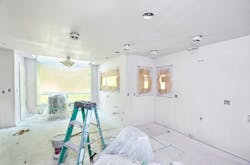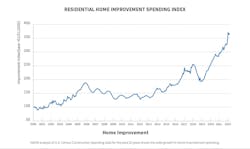Challenging Affordability Environment Offers Opportunities for Remodelers
Though it may seem counterintuitive, the growing housing affordability crisis offers new opportunities for remodelers.
Soaring mortgage interest rates have jumped from an average of 3.1% at the beginning of the year to 5.3% in early May, marking the highest rate in 12 years. This sudden surge in interest rates is a primary factor why housing affordability now stands at a more than 10-year low.
Indeed, based on the latest National Association of Home Builders (NAHB)/Wells Fargo Housing Opportunity Index, just 48.7% of all homes sold in the first quarter of 2022 were affordable to median- income families based on current mortgage rates.
Drops in Existing Home Availability
Another key economic factor for remodelers is that the number of existing homes for sale is at an historical low, meaning potential move-up buyers have fewer choices. At the same time, rising new home prices, driven by a 31% increase in the cost of building materials since the start of the COVID-19 pandemic, have discouraged buyers from shopping for new homes.
By the first quarter of 2022, and after falling for five straight quarters, the share of buyers looking for new construction returned to the pre-pandemic rate of 19% after peaking at 42% during the last quarter of 2020. And with mortgage rates above 5%, many homeowners who would normally be looking to sell have decided to stay put because they have attractive mortgage rates that are 2 points lower than current market rates.
Meanwhile, the median age of owner-occupied homes in the United States is 39 years. The age of the housing stock is an important remodeling market indicator. Older homes are less energy-efficient than new construction and ultimately will require remodeling and renovation in the future.
Moreover, as people use their homes for more purposes and require additional space, older housing represents an investment opportunity for homeowners. And while the pandemic shows signs of easing in many parts of the country, employers continue to adapt by offering more flexible telework schedules.
Rising Home Costs and Values
From the remodelers’ perspective, one silver lining from rapidly rising inflation and building material costs is that this has caused home prices to surge 18.8% in 2021, the biggest increase in the 34-year history of the S&P CoreLogic Case-Shiller U.S. National Home Price Index.
This means that homeowners are sitting on gold mines. From the third quarter of 2020 through the fourth quarter of last year, the value of owner-occupied real estate increased by $1.3 trillion. With soaring home price appreciation, this means that homeowners can more readily tap into the value of their home to fund remodeling projects.
Another demographic plus for remodelers is the aging population. More and more baby boomers and seniors are electing to age-in-place, and this means that there is growing demand for home modifications for seniors.
NAHB Remodelers reports that the most common aging-in-place remodeling projects include grab bars, installing higher toilets, curbless showers, widening doorways and adding additional outdoor lighting and indoor task lighting.
Meanwhile, a growing racial and ethnic rise in the U.S. population has brought an increase in multigenerational households, with three generations living under one roof.
Oftentimes there is a need for additional space for such living arrangements. Common projects for these households include finished basements, building additions, expanding kitchens and bathrooms, and adding an additional entrance.
“Given all these factors, residential remodeling activity is expected to increase 7% in 2022 following a growth rate of 13% in 2021, as people continue to use their home for more purposes such as offices, schools and gyms,” said NAHB Chief Economist Robert Dietz. “The surge in home equity has enabled more homeowners to finance remodeling projects that meet their needs.”
Remodeler Perspective
And how do remodelers feel?
The first quarter NAHB/Westlake Royal Remodeling Market Index, which gauges remodeler sentiment on current and future conditions in the market, posted a strong overall reading of 86 (a reading above 50 is positive).
“Despite supply chain problems and rising costs, remodeling demand remains high,” said NAHB Remodelers Chair Kurt Clason, a remodeler from Ossipee, N.H. “Business remains strong for most remodelers, and we expect to see continued growth this year and into 2023.”

